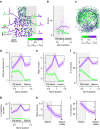A radial map of multi-whisker correlation selectivity in the rat barrel cortex
- PMID: 27869114
- PMCID: PMC5121329
- DOI: 10.1038/ncomms13528
A radial map of multi-whisker correlation selectivity in the rat barrel cortex
Abstract
In the barrel cortex, several features of single-whisker stimuli are organized in functional maps. The barrel cortex also encodes spatio-temporal correlation patterns of multi-whisker inputs, but so far the cortical mapping of neurons tuned to such input statistics is unknown. Here we report that layer 2/3 of the rat barrel cortex contains an additional functional map based on neuronal tuning to correlated versus uncorrelated multi-whisker stimuli: neuron responses to uncorrelated multi-whisker stimulation are strongest above barrel centres, whereas neuron responses to correlated and anti-correlated multi-whisker stimulation peak above the barrel-septal borders, forming rings of multi-whisker synchrony-preferring cells.
Figures





Similar articles
-
Imprecise Whisker Map in the Neonatal Rat Barrel Cortex.Cereb Cortex. 2015 Oct;25(10):3458-67. doi: 10.1093/cercor/bhu169. Epub 2014 Aug 6. Cereb Cortex. 2015. PMID: 25100857
-
Stimulus-specific and stimulus-nonspecific firing synchrony and its modulation by sensory adaptation in the whisker-to-barrel pathway.J Neurophysiol. 2009 May;101(5):2328-38. doi: 10.1152/jn.91151.2008. Epub 2009 Mar 11. J Neurophysiol. 2009. PMID: 19279146 Free PMC article.
-
Representation of tactile scenes in the rodent barrel cortex.Neuroscience. 2018 Jan 1;368:81-94. doi: 10.1016/j.neuroscience.2017.08.039. Epub 2017 Aug 23. Neuroscience. 2018. PMID: 28843997 Review.
-
Response sensitivity of barrel neuron subpopulations to simulated thalamic input.J Neurophysiol. 2010 Jun;103(6):3001-16. doi: 10.1152/jn.01053.2009. Epub 2010 Apr 7. J Neurophysiol. 2010. PMID: 20375248
-
Information processing streams in rodent barrel cortex: the differential functions of barrel and septal circuits.Cereb Cortex. 2008 May;18(5):979-89. doi: 10.1093/cercor/bhm138. Epub 2007 Aug 16. Cereb Cortex. 2008. PMID: 17702950 Review.
Cited by
-
Tuning instability of non-columnar neurons in the salt-and-pepper whisker map in somatosensory cortex.Nat Commun. 2022 Nov 3;13(1):6611. doi: 10.1038/s41467-022-34261-1. Nat Commun. 2022. PMID: 36329010 Free PMC article.
-
Global and local neuronal coding of tactile information in the barrel cortex.Front Neurosci. 2024 Jan 5;17:1291864. doi: 10.3389/fnins.2023.1291864. eCollection 2023. Front Neurosci. 2024. PMID: 38249584 Free PMC article.
-
Cross-Streams Through the Ventral Posteromedial Thalamic Nucleus to Convey Vibrissal Information.Front Neuroanat. 2021 Oct 28;15:724861. doi: 10.3389/fnana.2021.724861. eCollection 2021. Front Neuroanat. 2021. PMID: 34776879 Free PMC article.
-
Sensory coding is impaired in rat absence epilepsy.J Physiol. 2019 Feb;597(3):951-966. doi: 10.1113/JP277297. Epub 2019 Jan 4. J Physiol. 2019. PMID: 30548850 Free PMC article.
-
Organization of orientation-specific whisker deflection responses in layer 2/3 of mouse somatosensory cortex.Neuroscience. 2018 Jan 1;368:46-56. doi: 10.1016/j.neuroscience.2017.07.067. Epub 2017 Aug 4. Neuroscience. 2018. PMID: 28827090 Free PMC article.
References
-
- Fregnac Y. & Bathellier B. Cortical correlates of low-level perception: from neural circuits to percepts. Neuron 88, 110–126 (2015). - PubMed
-
- Ghazanfar A. A. & Nicolelis M. A. Nonlinear processing of tactile information in the thalamocortical loop. J. Neurophysiol. 78, 506–510 (1997). - PubMed
-
- Estebanez L., El Boustani S., Destexhe A. & Shulz D. E. Correlated input reveals coexisting coding schemes in a sensory cortex. Nat. Neurosci. 15, 1691–1699 (2012). - PubMed
-
- Merzenich M. M., Kaas J. H. & Roth G. L. Auditory cortex in the grey squirrel: tonotopic organization and architectonic fields. J. Comp. Neurol. 166, 387–401 (1976). - PubMed
Publication types
MeSH terms
Substances
LinkOut - more resources
Full Text Sources
Other Literature Sources

